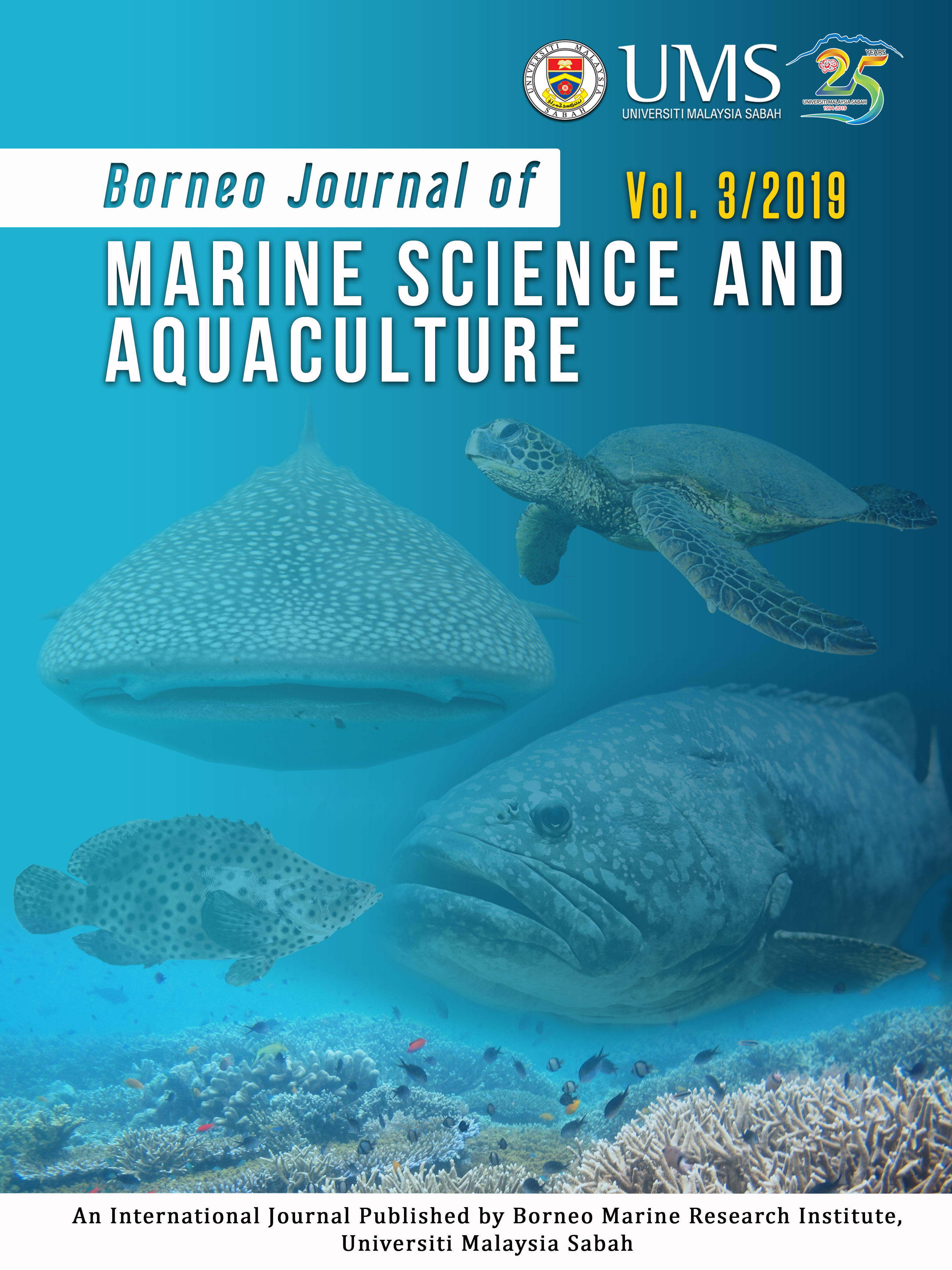Effects of hydrogen peroxide treatment on the particle size distribution of hydrothermal vent sediments: A case study in Guishan Island, Taiwan
DOI:
https://doi.org/10.51200/bjomsa.v3i2.1995Keywords:
Hydrothermal vent, Taiwan, Hydrogen peroxide, SedimentAbstract
Particle size analysis is able to reveal essential information about processes like production, transportation, sorting, and deposition of a study area. Pre-treatment of sediment by using hydrogen peroxide is recommended for more accuracy of particle size distribution as it removes organic matter which is adsorbed on the grain particle. A shallow water where hydrothermal vents site are located in Guishan Island is selected as the study site in this research. Sediment samples were collected at the depth of 3 – 5 cm from the seabed surface by SCUBA diving. Particle size analysis was conducted by dry sieving before and after hydrogen peroxide treatment. Results showed significant differences in very coarse sand (p < 0.05) as it decreases significantly in weight after treatment (10.62% of change). The other particle size level of sediment increases slightly in weight and the changes ranged from 1.20% to 2.60%, showing no significant difference (500μm=0.59; p value 250μm=0.67; p value 125μm=0.48; p value 63μm=0.47; p value >63μm=0.38). Therefore, in order to accurately determine the particle size distribution at hydrothermal vent site, pre-treatment using hydrogen peroxide is recommended to remove organic material because hydrothermal vent is proved to have high organic matter content.
References
Bazylinski, D.A., Farrington, J.W., & Jannasch, H.W. (1998). Hydrocarbons in Surface Sediments from A Guaymas Basin Hydrothermal Vent Site. Organic Geochemistry 12(6), 547-558.
Chen, C.A., Long, S.M., & Rosli, N.M. (2012). Spatial Distribution of Tropical Estuarine Nematode Communities in Sarawak, Malaysia (Borneo). The Raffles Bulletin of Zoology 60(1), 173-181.
Comita, P.B., Gagosian, R.B., & Williams, P.M. (1984). Suspended Particulate Organic Material from Hydrothermal Vent Waters At 21oN. Nature 307, 450-453.
Gray, A.B., Pasternack, G.B., & Watson, E.B. (2010). Hydrogen Peroxide Treatment Effects on The Particle Size Distribution of Alluvial Marsh Sediments. The Holocene 20(2), 293-301.
Hamouche, F. and Zentar, & R. (2018). Effects of Organic Matter on Mechanical Properties of Dredged Sediments for Beneficial Use in Road Construction. Environmental Technology.
Hedges, J.I., & Keil, R.G. (1995). Sedimentary Organic Matter Preservation: An Assessment and Speculative Synthesis. Marine Chemistry 49, 81-115.
Keller, G.H. (1982). Organic Matter and The Geotechnical Properties of Submarine Sediments. Geo-Marine Letters 2, 191-198.
Konert, M. & Vandenberghe, J. (1997). Comparison of Laser Grain Size Analysis with Pipette and Sieve Analysis: A Solution for The Underestimation of The Clay Fraction. Sedimentology 44, 523-535.
Konn, C. Charlou, J.L., Holm, N.G., & Mousis, O. (2015). The Production of Methane, Hydrogen, and Organic Compounds in Ultramafic-Hosted Hydrothermal Vents of the Mid-Atlantic Ridge. Astrobiology 15(5), 381-399.
Leifeld, J., & Kögel-Knabner, I. (2001). Organic Carbon and Nitrogen in Fine Soil Fractions After Treatment with Hydrogen Peroxide. Soil Biology and Biochemistry 33, 2155-2158.
Meyers, P.A., & Lallier-Verges, E. (1999). Lacustrine Sedimentary Organic Matter Records of Late Quaternary Paleoclimates. Journal of Paleolimnology 21, 345-372.
Mikutta, R., Kleber, M., Kaiser, K., & Jahn, R. (2005). Review: Organic Matter Removal from Soils using Hydrogen Peroxide, Sodium Hypochlorite, and Disodium Peroxodisulfate. Soil Science Society of America Journal 69, 120-135.
NOAA. What is Hydrothermal vent? National Ocean Service website, https://oceanservice.noaa.gov/facts/vents.html
Vasskog, K., Kvisvik, B.C., & Paasche, Ø. (2016). Effects of Hydrogen Peroxide Treatment on Measurements of Lake Sediment Grain-Size Distribution. Journal of Paleolimnology.
Wentworth, C. K. (1922). A Scale of Grade and Class Terms for Clastic Sediments. Journal of Geology 30(5), 377-392.
Zaghden, H., Tedetti, M., Sayadi, S., Serbaji, M.M., Elleuch, B. & Saliot, A. 2017. Origin and Distribution of Hydrocarbons and Organic Matter in The Surficial Sediments of The Sfax-Kerkennah Channel (Tunisia, Southern Mediterranean Sea). Marine Pollution Bulletin 117, 414-428.






